Abstract
Multiple indicator dilution studies of the pulmonary circulation were carried out in conscious, resting and exercising, and anesthetized dogs under conditions where there was no pulmonary edema. Labeled red cells, water, and albumin were injected together into the pulmonary artery, and effluent dilution patterns were obtained from the descending thoracic aorta. The product of the mean transit time differences between labeled water and red cells, and the pulmonary water flow was used to estimate extravascular parenchymatous water; and this was expressed as a proportion of the water content of the blood-drained lung at postmortem examination. These estimates of the proportional water content were found to increase with flow, and to approach an asymptotic value. Reconsideration of the flow patterns in capillaries, however, led to the postulate that extravascular water should be calculated, utilizing as the appropriate vascular reference a substance that uniformly labels the water in red cells and plasma, and which is confined to the circulation, rather than a tracer that only labels red cells. The mean transit time of this substance is approximated by the sum of the mean transit times of labeled red cells and albumin, each weighted according to the proportion of the water content of blood present in that phase. The values for lung water content so computed also increased with flow, and appeared to approach an asymptote that corresponded to approximately two-thirds of the wet lung weight. The estimated values for the water space after pentobarbital anesthesia corresponded to the lower values obtained in the resting conscious animals. When the anesthetized animals were also bled, the estimated water space was disproportionately large, in relation to the previous values. These experimental results support the hypothesis that dilutional estimates of the lung water space reflect pulmonary capillary filling; that this filling increases with exercise; and that a relative increase in filling also occurs as part of the response to hemorrhage.
Full text
PDF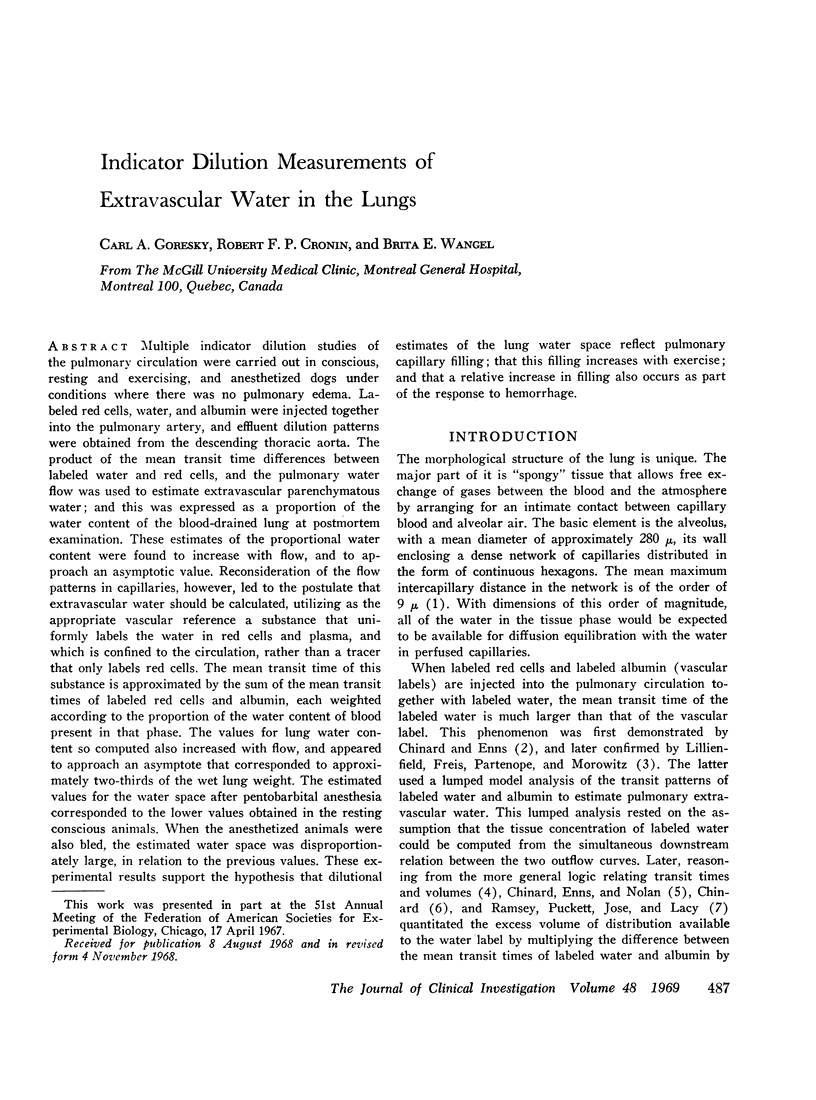



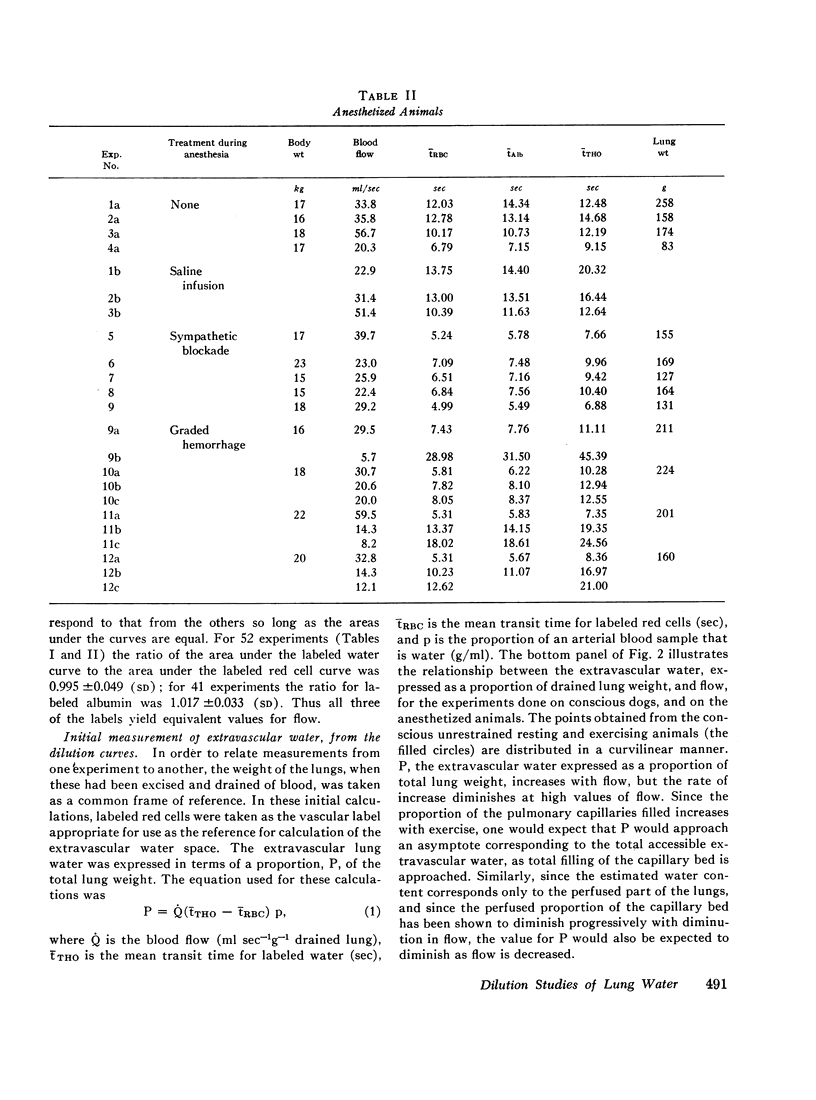
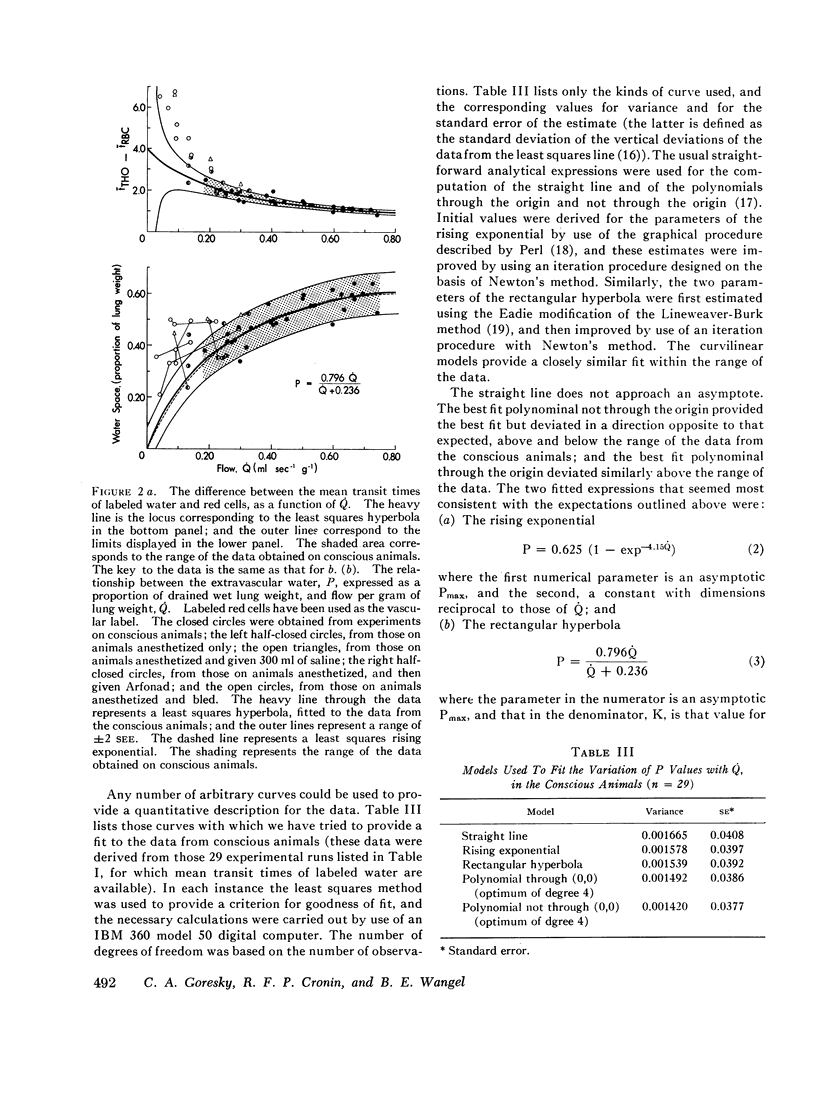

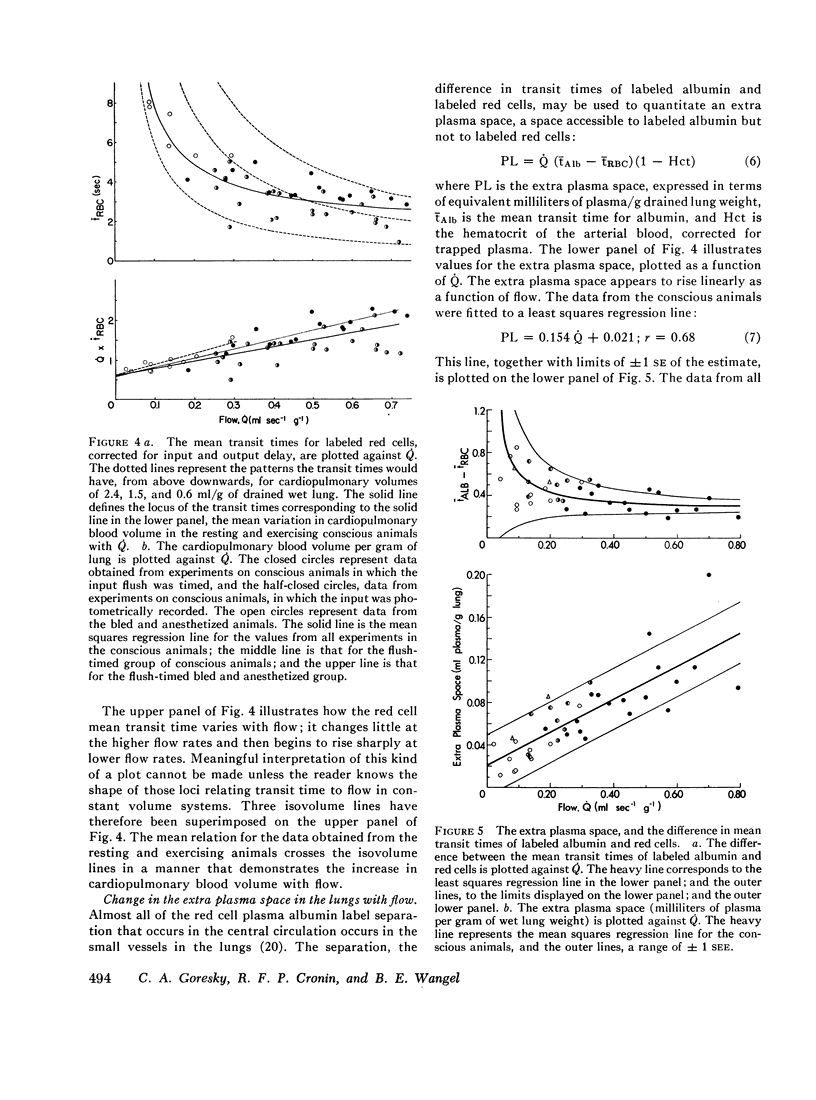
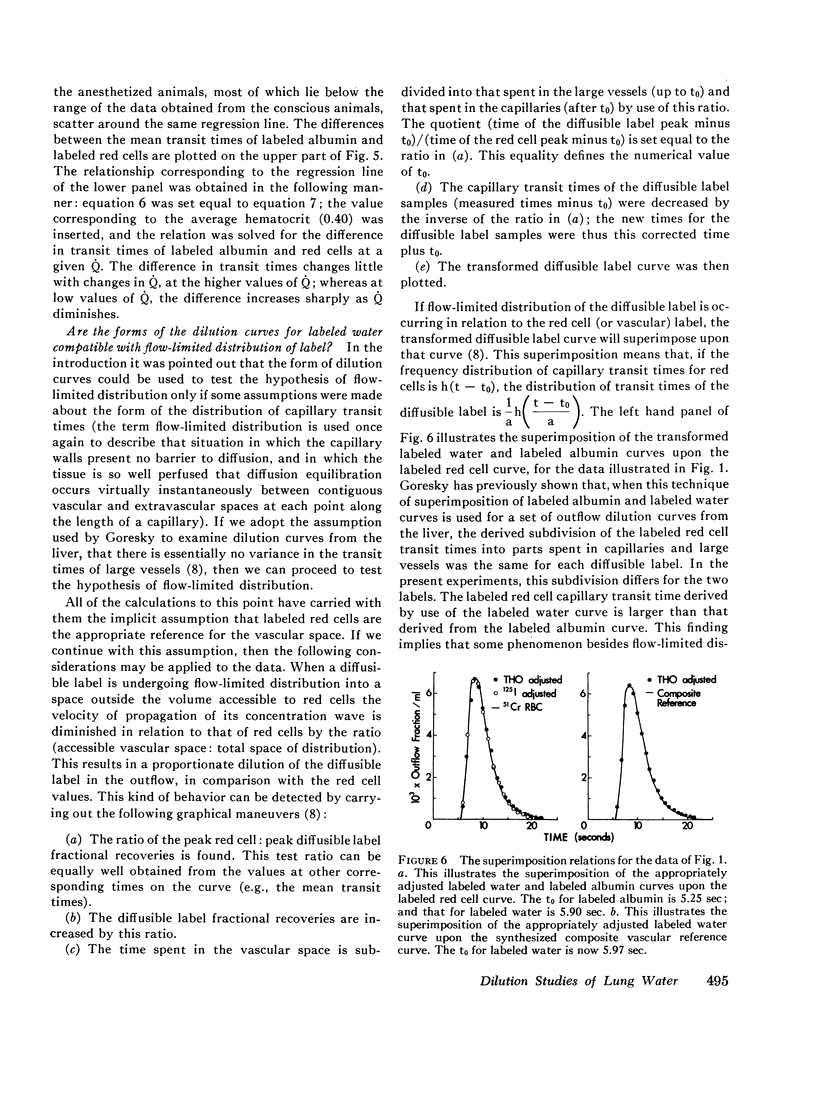
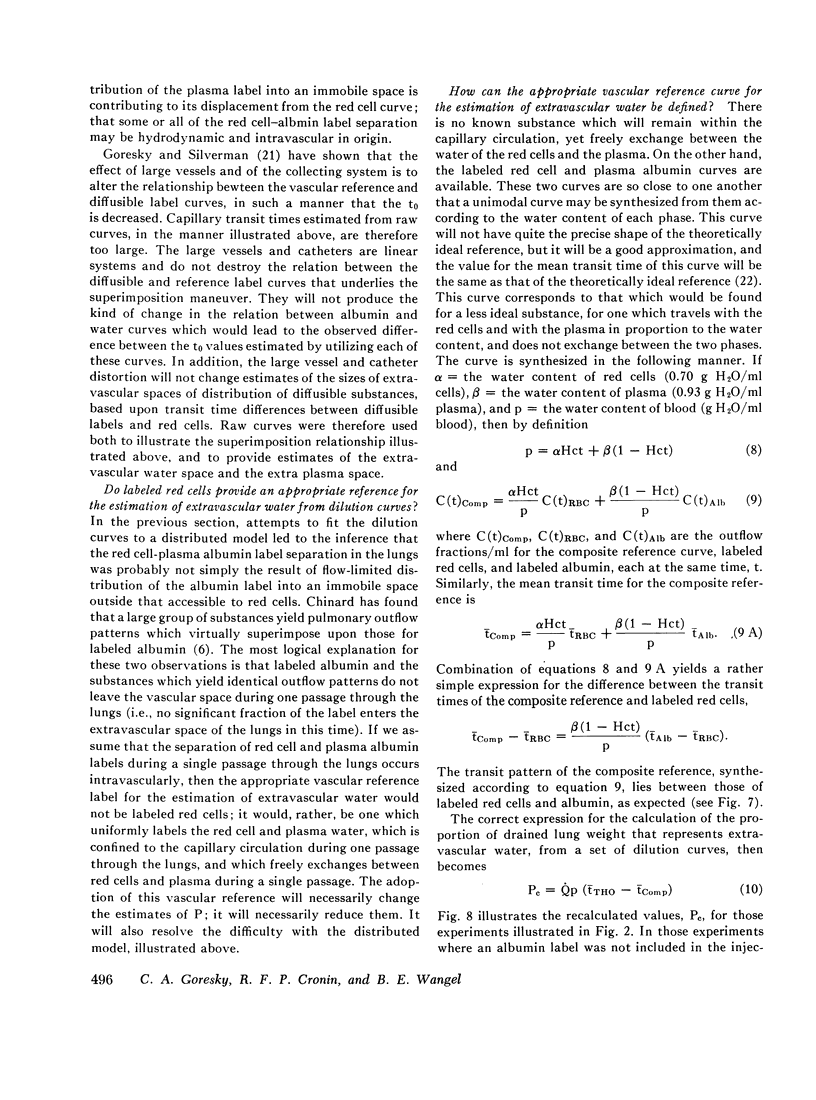


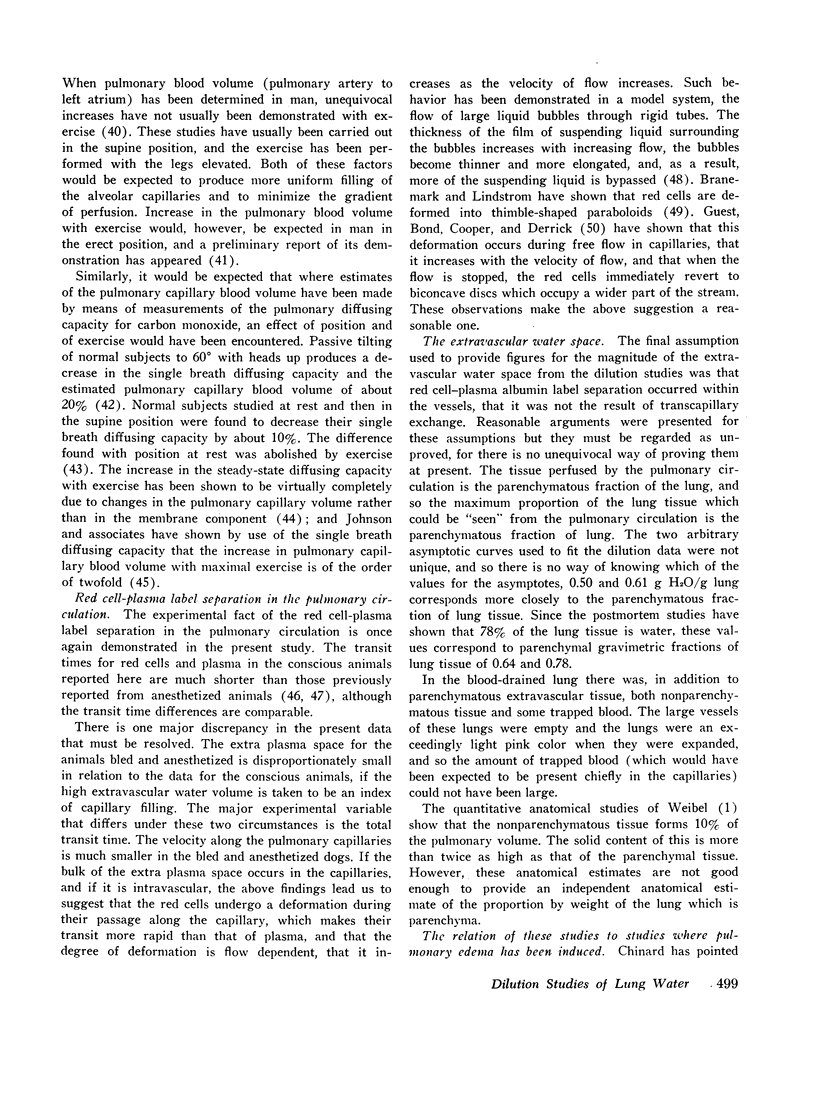
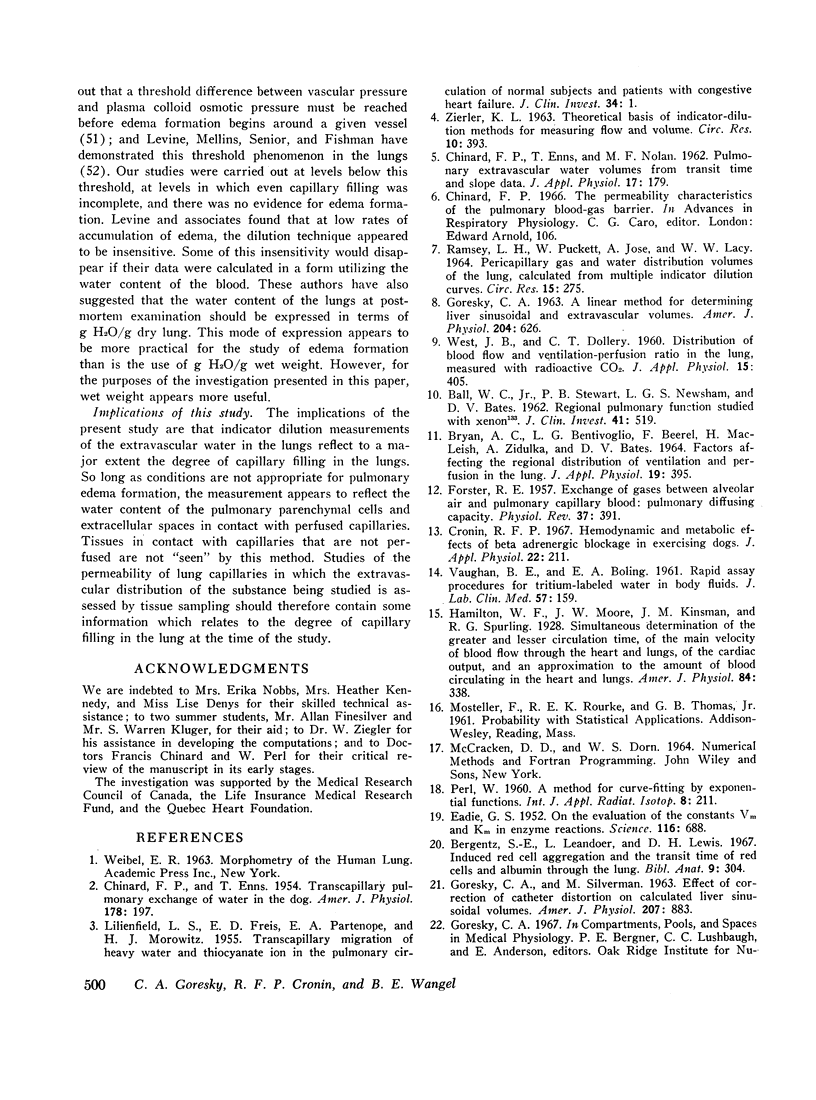
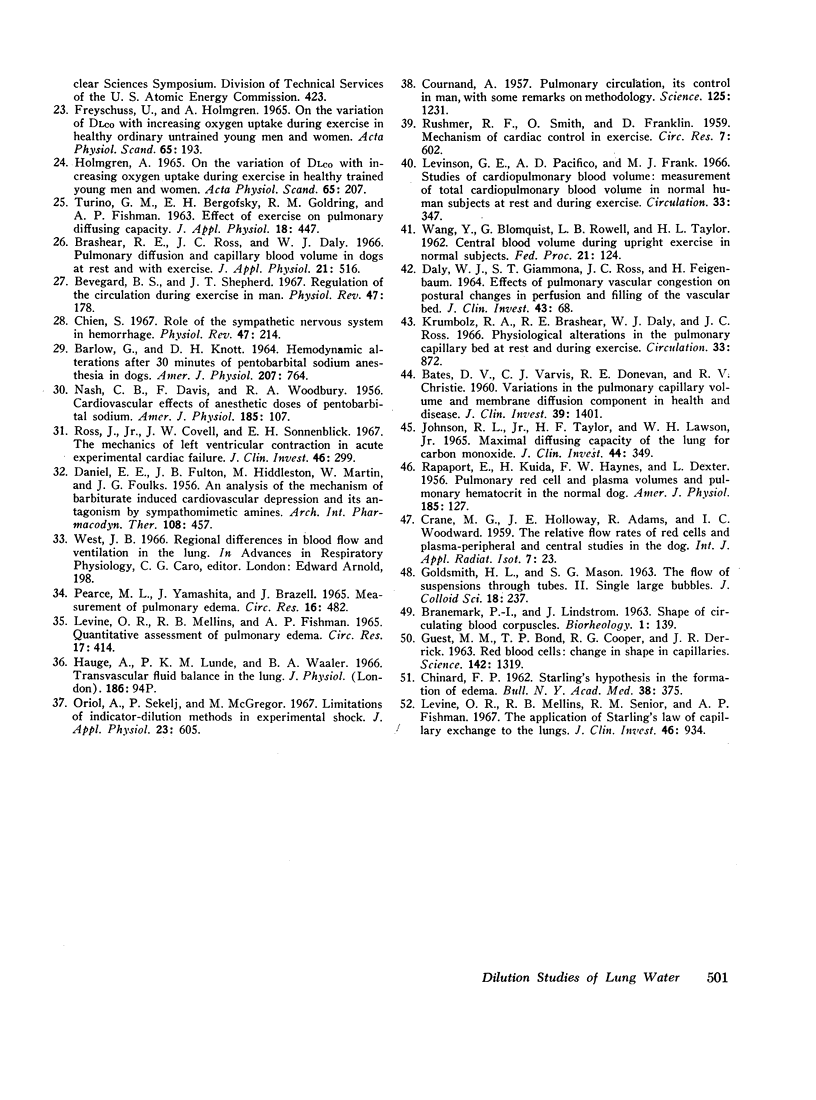
Selected References
These references are in PubMed. This may not be the complete list of references from this article.
- BALL W. C., Jr, STEWART P. B., NEWSHAM L. G., BATES D. V. Regional pulmonary function studied with xenon 133. J Clin Invest. 1962 Mar;41:519–531. doi: 10.1172/JCI104505. [DOI] [PMC free article] [PubMed] [Google Scholar]
- BARLOW G., KNOTT D. H. HEMODYNAMIC ALTERATIONS AFTER 30 MINUTES OF PENTOBARBITAL SODIUM ANESTHESIA IN DOGS. Am J Physiol. 1964 Oct;207:764–766. doi: 10.1152/ajplegacy.1964.207.4.764. [DOI] [PubMed] [Google Scholar]
- BATES D. V., VARVIS C. J., DONEVAN R. E., CHRISTIE R. V. Variations in the pulmonary capillary blood volume and membrane diffusion component in health and disease. J Clin Invest. 1960 Sep;39:1401–1412. doi: 10.1172/JCI104160. [DOI] [PMC free article] [PubMed] [Google Scholar]
- BRYAN A. C., BENTIVOGLIO L. G., BEEREL F., MACLEISH H., ZIDULKA A., BATES D. V. FACTORS AFFECTING REGIONAL DISTRIBUTION OF VENTILATION AND PERFUSION IN THE LUNG. J Appl Physiol. 1964 May;19:395–402. doi: 10.1152/jappl.1964.19.3.395. [DOI] [PubMed] [Google Scholar]
- Bergentz S. E., Leandoer L., Lewis D. H. Induced red cell aggregation and the transit time of red cells and plasma through the lung. Bibl Anat. 1967;9:304–310. [PubMed] [Google Scholar]
- Bevegård B. S., Shepherd J. T. Regulation of the circulation during exercise in man. Physiol Rev. 1967 Apr;47(2):178–213. doi: 10.1152/physrev.1967.47.2.178. [DOI] [PubMed] [Google Scholar]
- Brashear R. E., Ross J. C., Daly W. J. Pulmonary diffusion and capillary blood volume in dogs at rest and with exercise. J Appl Physiol. 1966 Mar;21(2):516–520. doi: 10.1152/jappl.1966.21.2.516. [DOI] [PubMed] [Google Scholar]
- CHINARD F. P., ENNS T. Transcapillary pulmonary exchange of water in the dog. Am J Physiol. 1954 Aug;178(2):197–202. doi: 10.1152/ajplegacy.1954.178.2.197. [DOI] [PubMed] [Google Scholar]
- CHINARD F. P. Starling's hypothesis in the formation of edema. Bull N Y Acad Med. 1962 Jun;38:375–389. [PMC free article] [PubMed] [Google Scholar]
- COURNAND A. Pulmonary circulation; its control in man, with some remarks or methodology. Science. 1957 Jun 21;125(3260):1231–1235. doi: 10.1126/science.125.3260.1231. [DOI] [PubMed] [Google Scholar]
- CRANE M. G., HOLLOWAY J. E., ADAMS R., WOODWARD I. C. The relative flow rates of red cells and plasma--peripheral and central circulation studies in the dog. Int J Appl Radiat Isot. 1959 Nov;7:23–32. doi: 10.1016/0020-708x(59)90276-5. [DOI] [PubMed] [Google Scholar]
- Chien S. Role of the sympathetic nervous system in hemorrhage. Physiol Rev. 1967 Apr;47(2):214–288. doi: 10.1152/physrev.1967.47.2.214. [DOI] [PubMed] [Google Scholar]
- Cronin R. F. Hemodynamic and metabolic effects of beta-adrenergic blockade in exercising dogs. J Appl Physiol. 1967 Feb;22(2):211–216. doi: 10.1152/jappl.1967.22.2.211. [DOI] [PubMed] [Google Scholar]
- DALY W. J., GIAMMONA S. T., ROSS J. C., FEIGENBAUM H. EFFECTS OF PULMONARY VASCULAR CONGESTION ON POSTURAL CHANGES IN THE PERFUSION AND FILLING OF THE PULMONARY VASCULAR BED. J Clin Invest. 1964 Jan;43:68–76. doi: 10.1172/JCI104895. [DOI] [PMC free article] [PubMed] [Google Scholar]
- DANIEL E. E., FULTON J. B., HIDDELSTON M., MARTIN W., FOULKS J. G. An analysis of the mechanism of barbiturate-induced cardiovascular depression and its antagonism by sympathomimetic amines. Arch Int Pharmacodyn Ther. 1956 Dec 1;108(3-4):457–472. [PubMed] [Google Scholar]
- EADIE G. S. On the evaluation of the constants Vm and Km in enzyme reactions. Science. 1952 Dec 19;116(3025):688–688. doi: 10.1126/science.116.3025.688. [DOI] [PubMed] [Google Scholar]
- FORSTER R. E. Exchange of gases between alveolar air and pulmonary capillary blood: pulmonary diffusing capacity. Physiol Rev. 1957 Oct;37(4):391–452. doi: 10.1152/physrev.1957.37.4.391. [DOI] [PubMed] [Google Scholar]
- Freyschuss U., Holmgren A. On the variation of D-LCO with increasing oxygen uptake during exercise in healthy ordinarily untrained young men and women. Acta Physiol Scand. 1965 Nov;65(3):193–206. doi: 10.1111/j.1748-1716.1965.tb04263.x. [DOI] [PubMed] [Google Scholar]
- GORESKY C. A. A linear method for determining liver sinusoidal and extravascular volumes. Am J Physiol. 1963 Apr;204:626–640. doi: 10.1152/ajplegacy.1963.204.4.626. [DOI] [PubMed] [Google Scholar]
- GORESKY C. A., SILVERMAN M. EFFECT OF CORRECTION OF CATHETER DISTORTION ON CALCULATED LIVER SINUSOIDAL VOLUMES. Am J Physiol. 1964 Oct;207:883–892. doi: 10.1152/ajplegacy.1964.207.4.883. [DOI] [PubMed] [Google Scholar]
- GUEST M. M., BOND T. P., COOPER R. G., DERRICK J. R. RED BLOOD CELLS: CHANGE IN SHAPE IN CAPILLARIES. Science. 1963 Dec 6;142(3597):1319–1321. doi: 10.1126/science.142.3597.1319. [DOI] [PubMed] [Google Scholar]
- Holmgren A. On the variation of D-LCO with increasing oxygen uptake during exercise in healthy trained young men and women. Acta Physiol Scand. 1965 Nov;65(3):207–220. doi: 10.1111/j.1748-1716.1965.tb04264.x. [DOI] [PubMed] [Google Scholar]
- JOHNSON R. L., Jr, TAYLOR H. F., LAWSON W. H., Jr MAXIMAL DIFFUSING CAPACITY OF THE LUNG FOR CARBON MONOXIDE. J Clin Invest. 1965 Mar;44:349–355. doi: 10.1172/JCI105148. [DOI] [PMC free article] [PubMed] [Google Scholar]
- Krumholz R. A., Brashear R. E., Daly W. J., Ross J. C. Physiological alterations in the pulmonary capillary bed at rest and during exercise. The effect of body position and trimethaphan camphorsulfonate. Circulation. 1966 Jun;33(6):872–877. doi: 10.1161/01.cir.33.6.872. [DOI] [PubMed] [Google Scholar]
- LILIENFIELD L. S., FREIS E. D., PARTENOPE E. A., MOROWITZ H. J. Transcapillary migration of heavy water and thiocyanate ion in the pulmonary circulation of normal subjects and patients with congestive heart failure. J Clin Invest. 1955 Jan;34(1):1–8. doi: 10.1172/JCI103051. [DOI] [PMC free article] [PubMed] [Google Scholar]
- Levine O. R., Mellins R. B., Fishman A. P. Quantitative assessment of pulmonary edema. Circ Res. 1965 Nov;17(5):414–426. doi: 10.1161/01.res.17.5.414. [DOI] [PubMed] [Google Scholar]
- Levine O. R., Mellins R. B., Senior R. M., Fishman A. P. The application of Starling's law of capillary exchange to the lungs. J Clin Invest. 1967 Jun;46(6):934–944. doi: 10.1172/JCI105599. [DOI] [PMC free article] [PubMed] [Google Scholar]
- Levinson G. E., Pacifico A. D., Frank F. M. Studies of cardiopulmonary blood volume. Measurement of total cardiopulmonary blood volume in normal human subjects at rest and during exercise. Circulation. 1966 Mar;33(3):347–356. doi: 10.1161/01.cir.33.3.347. [DOI] [PubMed] [Google Scholar]
- NASH C. B., DAVIS F., WOODBURY R. A. Cardiovascular effects of anesthetic doses of pentobarbital sodium. Am J Physiol. 1956 Apr;185(1):107–112. doi: 10.1152/ajplegacy.1956.185.1.107. [DOI] [PubMed] [Google Scholar]
- Oriol A., Sekelj P., McGregor M. Limitations of indicator-dilution methods in experimental shock. J Appl Physiol. 1967 Oct;23(4):605–608. doi: 10.1152/jappl.1967.23.4.605. [DOI] [PubMed] [Google Scholar]
- PEARCE M. L., YAMASHITA J., BEAZELL J. MEASUREMENT OF PULMONARY EDEMA. Circ Res. 1965 May;16:482–488. doi: 10.1161/01.res.16.5.482. [DOI] [PubMed] [Google Scholar]
- RAMSEY L. H., PUCKETT W., JOSE A., LACY W. W. PERICAPILLARY GAS AND WATER DISTRIBUTION VOLUMES OF THE LUNG CALCULATED FROM MULTIPLE INDICATOR DILUTION CURVES. Circ Res. 1964 Oct;15:275–286. doi: 10.1161/01.res.15.4.275. [DOI] [PubMed] [Google Scholar]
- RAPAPORT E., KUIDA H., HAYNES F. W., DEXTER L. Pulmonary red cell and plasma volumes and pulmonary hematocrit in the normal dog. Am J Physiol. 1956 Apr;185(1):127–132. doi: 10.1152/ajplegacy.1956.185.1.127. [DOI] [PubMed] [Google Scholar]
- RUSHMER R. F., SMITH O., FRANKLIN D. Mechanisms of cardiac control in exercise. Circ Res. 1959 Jul;7(4):602–627. doi: 10.1161/01.res.7.4.602. [DOI] [PubMed] [Google Scholar]
- Ross J., Jr, Covell J. W., Sonnenblick E. H. The mechanics of left ventricular contraction in acute experimental cardiac failure. J Clin Invest. 1967 Mar;46(3):299–312. doi: 10.1172/JCI105532. [DOI] [PMC free article] [PubMed] [Google Scholar]
- VAUGHAN B. E., BOLING E. A. Rapid assay procedures for tritium-labeled water in body fluids. J Lab Clin Med. 1961 Jan;57:159–164. [PubMed] [Google Scholar]
- WEST J. B., DOLLERY C. T. Distribution of blood flow and ventilation-perfusion ratio in the lung, measured with radioactive carbon dioxide. J Appl Physiol. 1960 May;15:405–410. doi: 10.1152/jappl.1960.15.3.405. [DOI] [PubMed] [Google Scholar]


